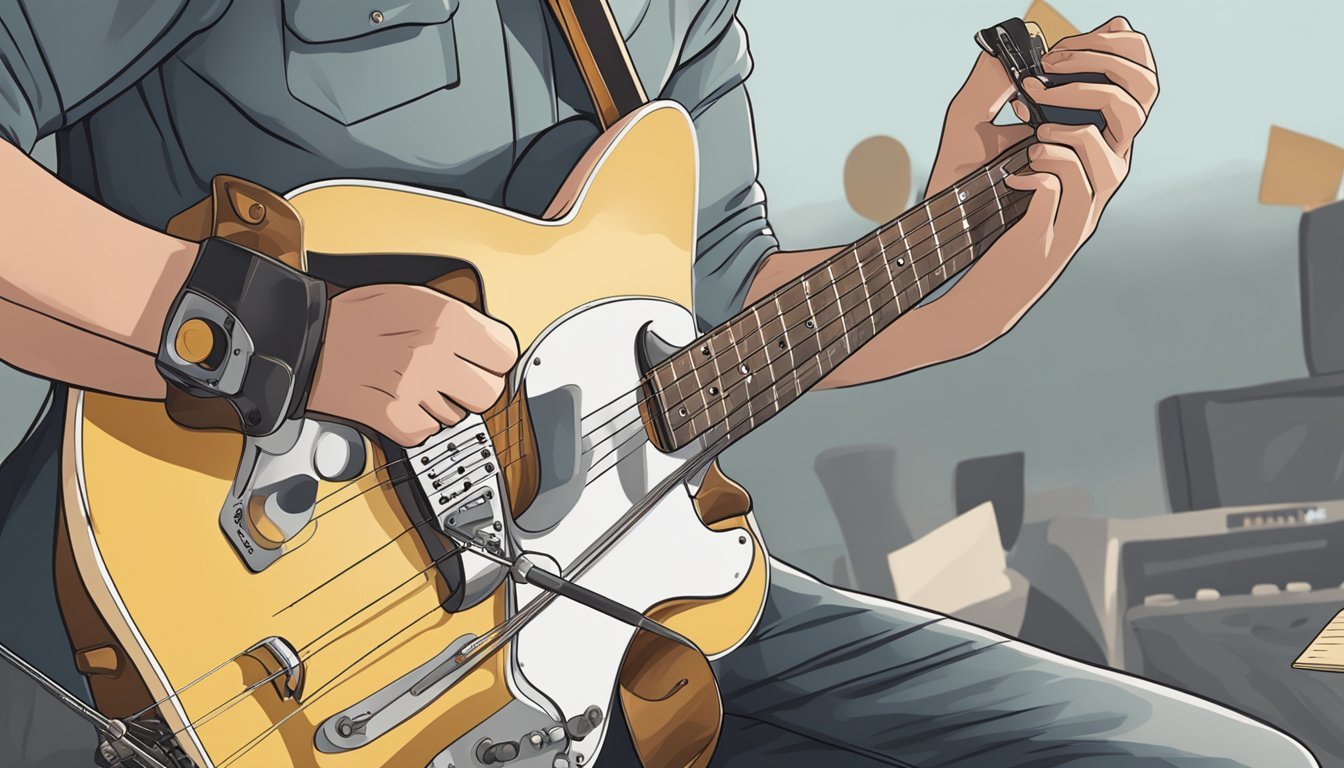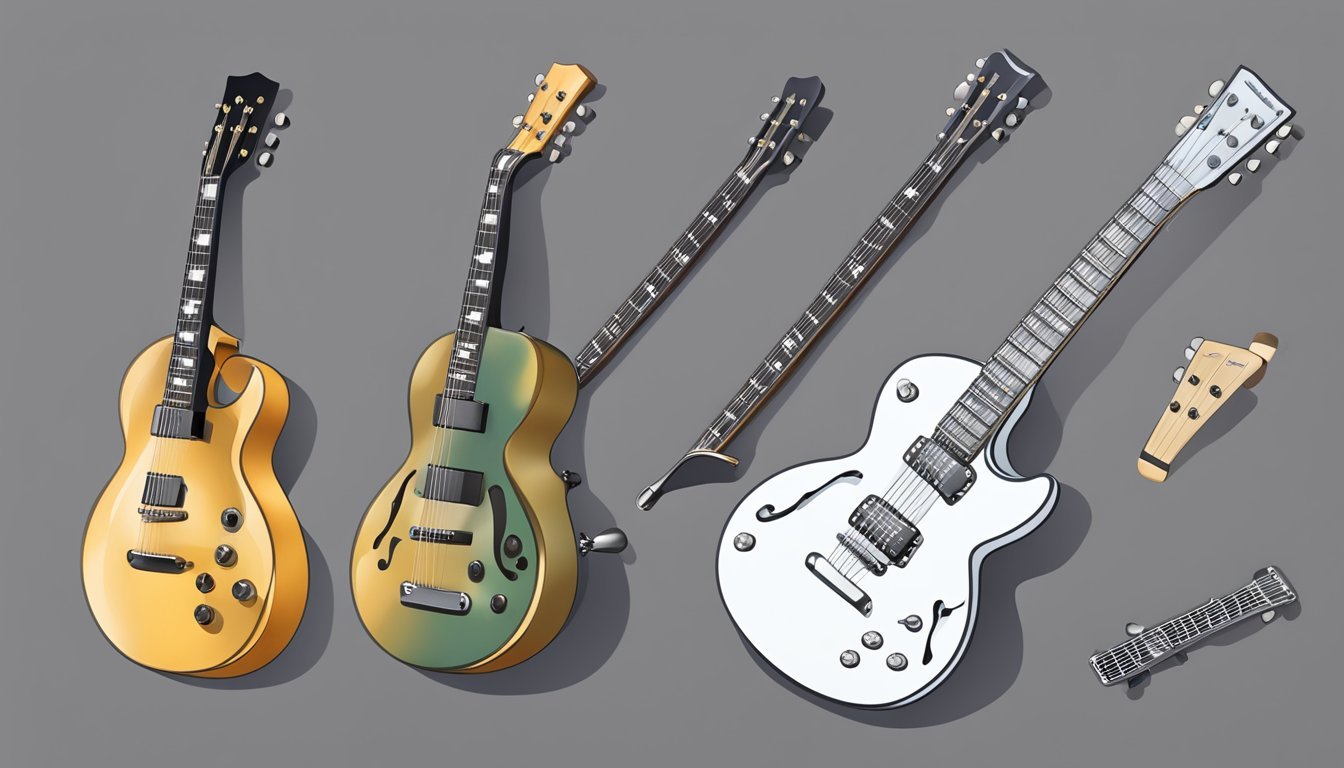Learning to play guitar tabs is an exciting way to get started on your musical journey. You can easily read and play your favorite songs using simple numbers and lines that represent the guitar strings and frets. Guitar tablature, or tabs, breaks down the music into an easy-to-understand format, making it perfect for beginners.

As you dive into the world of guitar tabs, you’ll discover techniques that help you improve your playing skills.
Understanding how to interpret these symbols and applying them to popular songs will keep you motivated and engaged.
With the right approach, you can quickly move from basic exercises to playing real music that you love.
Embracing this fun and accessible method of learning is the key to becoming a confident guitarist.
The more you practice reading tabs, the more you’ll find joy in creating sound with your guitar.
Key Takeaways
- Guitar tabs simplify the process of learning to play songs.
- Understanding tabs boosts your confidence as a beginner guitarist.
- Practice makes it easier to read and play your favorite music.
Decoding Guitar Tablature
Guitar tablature, or tabs, is a simple way to show you how to play music on the guitar.
It uses numbers and lines to represent the strings and frets, making it easier to learn songs.
Let’s break down how to read guitar tabs so you can start playing.
Understanding the Basics
Guitar tab has six lines, each representing a string on your guitar.
The bottom line is the lowest string (E), and the top line is the highest string (e).
Numbers on the lines tell you which fret to press down.
For example, a “3” on the bottom line means to play the third fret of the low E string.
If there’s no number, that string is not played.
You can have multiple numbers stacked vertically, meaning you hit those notes at the same time.
This is how chords are represented in tabs.
Reading Guitar Tab Symbols
There are many symbols used in guitar tab to show different techniques.
Here are some key ones:
- Hammer-on (h): If you see “7h9,” it means you pick the 7th fret and then hammer a finger onto the 9th fret.
- Pull-off (p): Notated as “9p7,” this means you pick the 9th fret and then pull off to the 7th fret.
- Bend (b): If you see “7b9,” you need to bend the note at the 7th fret to reach the pitch of the 9th fret.
These symbols add flair and expression to your playing, so it’s good to practice using them.
Exploring Rhythm and Timing
Rhythm is essential in music, and guitar tabs often show it in a simple way.
While the basic tab gives you notes, the timing might be less clear.
You can find the time signature and tempo indicated at the start of the song.
To get the rhythm right, listen to the song as you play.
Count the beats in a measure, and try to match your strumming or picking to the song.
If the tab has dashes, they indicate how long to hold a note.
Including these timing elements will help you sound more like the original recording.
Understanding how rhythm works with tabs is key to making your playing sound great.
Guitar Tab Techniques
Learning guitar tab techniques can really add flair to your playing style.
You’ll explore methods like hammer-ons, pull-offs, slides, and bends.
These techniques will help you express your musical ideas more freely.
Mastering the Art of Hammer-Ons and Pull-Offs
Hammer-ons and pull-offs are essential techniques in guitar playing.
A hammer-on happens when you pluck a note and then “hammer” your finger onto a higher fret without picking again.
This creates a smooth transition.
For example, to play a hammer-on from the 5th fret to the 7th fret on a string, pick the 5th fret note and then quickly press down on the 7th fret.
Pull-offs work in the opposite way.
You start on a higher fret, pluck the string, and then pull your finger off to sound a lower note.
For instance, start on the 7th fret and pull off to the 5th fret.
Executing Slides and Bends
Slides and bends can make your solos soar.
A slide involves moving your finger along the string from one fret to another.
This adds smoothness.
You write a slide in tab with a forward slash (/) for sliding up or a backslash () for sliding down.
For bends, you play a note and then push the string to raise its pitch.
In tab, bends are shown with a letter “b.” For a half-step bend, push the string up slightly.
For a whole-step bend, push it up more.
Incorporating Advanced Techniques
Once you’ve mastered basic techniques, it’s time to get into advanced ones like tapping, vibrato, and harmonics.
Tapping lets you use your picking hand to strike a note, creating a fast and lively sound.
It’s commonly notated in tabs with “T.”
Vibrato adds expressiveness by slightly bending the note back and forth.
This can be achieved by quickly moving the finger that is fretting the note.
Natural harmonics can be fun too.
Lightly touch a string above the fret without pressing down fully and pluck it.
For pinch harmonics, you’ll pick the string and lightly touch it with your thumb for a sharp tone.
These techniques can unlock new sounds in your playing.
Tuning and Equipment

Getting your guitar properly tuned is crucial before you start playing tabs.
Tuning ensures that your instrument sounds right and helps you avoid bad habits.
Additionally, having the right tools can make a big difference in how comfortable you feel while playing.
Getting in Tune
To begin, use a reliable tuner for accuracy.
Clip-on tuners work well if you’re on the go, while pedal tuners offer precision for live settings.
Standard tuning is E-A-D-G-B-e, but feel free to explore alternate tunings.
If you’re playing songs by artists like John Mayer or Van Halen, check their tuning preferences.
Many of their popular tracks use standard tuning, which means you can follow along easily.
Remember to stretch your strings a bit after tuning.
This will help stabilize them so you won’t have to retune mid-song.
Also, after changing strings, play for a bit to ensure they hold their pitch.
Tool Talk: Accessories for Playability
Having the right tools makes a big difference in your playing experience.
First, consider a quality set of strings.
Brands like Fender provide a variety of strings suitable for different styles—from light to heavy gauges.
Next, a comfortable capo can help you play in different keys without needing to change your tuning.
This is useful for various genres and Emulating artists like John Mayer.
Don’t underestimate the importance of a good guitar pick.
Experiment with different thicknesses to find what feels best for your playing style.
Finally, keep some basic tools handy for maintenance.
A string winder and cutter will help you change strings quickly, while a tuner and cleaning cloth keep everything in top shape.
Proper equipment enhances your fretboard time and keeps you focused on playing those tabs.
Playing Tabs for Popular Songs
When it comes to learning guitar tabs for popular songs, each artist has a unique style.
You can explore the signature sounds of Metallica, the shredding prowess of Van Halen, and John Mayer’s rhythmic flair.
Each section below highlights key techniques you can use to play these songs.
Approaching Metallica’s Signature Sound
To capture Metallica’s intense sound, focus on power chords and aggressive strumming patterns.
Their music often relies on distorted electric guitars, so make sure to use a good amp setting for that crunch.
Key Techniques:
- Power Chords: Use root and fifth notes, usually at the 5th or 7th fret.
- Palm Muting: Lightly rest your palm on the strings near the bridge to create a percussive sound.
Listen closely to songs like “Enter Sandman.” Pay attention to how they use guitar tablature and note durations.
This familiarity will help you nail the rhythmic feel.
Channeling Van Halen’s Shredding Style
Van Halen’s guitar work is all about speed and technique.
Focus on using legato techniques like hammer-ons and pull-offs to get that fluid sound.
Essential Elements:
- Tapping: Use your pick hand to tap on the fretboard. This adds a unique punch to your playing.
- Strumming Patterns: Experiment with both rhythmic strumming and quick pick strokes, especially during solos.
Songs like “Eruption” showcase these techniques beautifully.
Practicing with tablature will help you master each section accurately.
Emulating John Mayer’s Rhythmic Flair
John Mayer combines blues and pop in a way that’s really distinctive.
Pay attention to his strumming patterns and subtle bends when you play his songs.
Must-Know Techniques:
- Chord Voicings: Use open chords and unique finger placements to get that jangly sound.
- Slide Techniques: Utilize legato slides for a smooth transition between chords and notes.
Songs like “Gravity” highlight his style.
Following along with sheet music or guitar tablature will help you pick up these nuances effectively.
Frequently Asked Questions
Learning to play tabs can seem tricky at first, but it’s really just about getting the hang of a few key ideas.
Whether you’re wondering how to start or if you need special techniques, you’ll find some helpful info here.
What’s the easiest way to start learning guitar tabs for a total newbie?
Begin with simple tabs that highlight one or two strings.
Focus on understanding the numbers and lines.
Websites like Ultimate Guitar have beginner-friendly tabs that can make this easier for you.
As you become more comfortable with playing simple tabs, you can gradually introduce more complexity into your practice regimen.
This foundational knowledge will not only enhance your guitar skills but also pave the way for when you learn how to start songwriting on guitar.
Experimenting with different chords and melodies can ignite your creativity, helping you to develop your unique musical voice.
Got any tips for reading guitar tabs quickly and accurately?
Practice is key! Try to look for patterns in the tabs.
Also, familiarize yourself with common symbols like bends and slides.
The more you read, the faster you’ll get.
Can I play any tune with guitar tabs even if I’ve never had a guitar lesson?
Yes, you can! Many tabs are designed for beginners.
Just find a song you love and follow the tab.
It’s a great way to learn as you go.
Do guitar tabs include chords or are they just for single-note melodies?
Tabs can include both.
Some tabs show single notes while others display chords.
You can find a variety of both types online.
Where can I find guitar tabs for my favorite songs without spending a dime?
You can check out sites like Ultimate Guitar or National Guitar Academy.
They offer a lot of free tabs from popular songs.
Is fingerpicking necessary for playing guitar tabs, or can I use a pick?
You can use either! Many songs can be played with a pick, but fingerpicking adds a different sound.
Try both and see what you like best.

